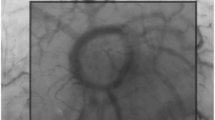Abstract
The microcirculation is an extremely important part of the body where blood interacts with tissue to create an environment necessary for cell survival [1]. As such, an understanding of its function under both physiological and pathophysiological conditions provides real insight into the disease processes. Furthermore, as the site of interaction between blood and tissue, the microcirculation also provides the link between clinical medicine and molecular biology [1]. However, the clinical importance of the microcirculation is often overlooked due to the difficulty associated with its visualization in humans. Most observations of the microcirculation in humans have been limited to blood vessels that are visible and close to the surface, the skin and nailfold capillaries and the eye, which have found limited clinical applications [2–5]. Skin and nailfold capillaroscopy has been used in the diagnosis and treatment of peripheral vascular diseases, diabetes and hypertension [1, 2, 6]. Due to the difficulty associated with holding the eye absolutely motionless, the usefulness of microvascular measurements in the bulbar conjuctiva for clinical application in ophthalmology is very restricted [3–5]. Recently laser scanning confocal imaging has been used to study the microcirculation [7]. However, the images can only be collected at a fraction of the normal video rate, making the observation of dynamic events difficult. Furthermore, the acquisition of these images usually requires the use of fluorescent dyes for contrast enhancement [8]. Using fluorescent dyes and large, conventional microscopes, the microcirculation has been studied extensively in many animal models, and from these studies we have gained important information about its function and importance in disease states. The transfer of this knowledge directly into clinical practice has been limited due to the difficulty in quantitatively accessing the microcirculation of humans. The need for transillumination or the use of fluorescent dyes, as well as the large size of the instrumentation necessary to produce real time images of the microcirculation which can be quantitatively analyzed has prevented the widespread clinical use of techniques to directly study the micro circulation. The ability to quantitatively measure the nutritive perfusion of the vital organs in humans would have important diagnostic implications in clinical medicine.
Access this chapter
Tax calculation will be finalised at checkout
Purchases are for personal use only
Preview
Unable to display preview. Download preview PDF.
Similar content being viewed by others
References
Fagrell B, Intaglietta M (1997) Microcirculation: its significance in clinical and molecular medicine. J Intern Med 241: 349–362
Fagrell B, Bollinger A (1990) Clinical capillaroscopy: A guide to its use in clinical research and practice. Hogrefe and Huber, Seattle, Washington
Davis E, Landau J (1966) Clinical capillary microscopy. Thomas, Springfield
Fenton BM, Zweifach BW, Worthen DM (1979) Quantitative morphometry of conjunctival microcirculation in diabetes mellitus. Microvasc Res 18: 153–166
Wolf S, Arend O, Schulte K, Ittel TH, Reim M (1994) Quantification of retinal capillary density and flow velocity in patients with essential hypertension. Hypertension 23: 464–467
Forst T, Pfützner A, et al (1998) Skin microcirculation in patients with type I diabetes with and without neuropathy after neurovascular stimulation. Clin Sci 94: 255–261
Bussau LJ, Vo LT, Delaney PM, Papworth GD, Barkla DH, King RG (1998) Fibre optic confocal imaging ( FOCI) of keratinocytes, blood vessels and nerves in hairless mouse skin in vivo. J Anat 192: 187–194
Rajadhyaksha M, Grossman M, Esterowitz D, Webb RH, Anderson RR (1995) In vivo confocal scanning laser microscopy of human skin: Melanin provides strong contrast. J Invest Dermatol 104: 946–952
Groner W, Winkelman JW, Harris AG, et al (1999) Orthogonal polarization spectral imaging: A new method for study of the microcirculation. Nature Med 5: 1209–1213
McKintosh FC, Zhu JX, Pine DJ, Weitz DA (1989) Polarization memory of multiply scattered light. Physical Review B 40: 9342–9345
Schmitt JM, Gandjbakhche AH, Bonner RF (1992) Use of polarized light to discriminate short-path photons in a multiply scattering medium. Appl Opt 31: 6535–6546
Klyscz T, Jünger M, Jung F, Zeintl H (1997) Cap image: a newly developed computer aided videoframe analysis system for dynamic capillaroscopy. Biomedizinische Technik 42: 168–175
Harris AG, Leiderer R, Peer F, Messmer K (1996) Skeletal muscle microvascular and tissue injury after varying durations of ischemia. Am J Physiol 271: H2388 - H2398
Harris AG, Hecht R, Peer F, Nolte D, Messmer K (1997) An improved intravital microscopy system. Int J Microcirc Clin Exp 17: 322–327
Nolte D, Menger MD, Messmer K (1995) Microcirculatory models of ischaemia-reperfusion in skin and striated muscle. Int J Microcirc Clin Exp 15 (suppl 1): 9–16
Bland JM, Altman DG (1995) Comparing methods of measurement: why plotting difference against standard method is misleading. Lancet 346: 1085–1087
Bland JM, Altman DG (1986) Statistical methods for assessing agreement between two methods of clinical measurement. Lancet 1: 307–310
Langer S, von Dobschuetz E, Harris AG, Krombach F, Messmer K (2000) Validation of the OPS imaging technique on rat liver and pancreas. Prog Appl Microcirc (in press)
Messmer K (2000) Progress in Applied Microcirculation Vol 24, Karger, Basel (in press)
** X, Weil MH, Sun S, Tang W, Bisera J, Mason EJ (1998) Decreases in organ blood flows associated with increases in sublingual PCO2 during hemorrhagic shock. J Appl Physiol 85: 2360–2364
Editor information
Editors and Affiliations
Rights and permissions
Copyright information
© 2000 Springer-Verlag Berlin Heidelberg
About this paper
Cite this paper
Harris, A.G., Langer, S., Messmer, K. (2000). The Study of the Microcirculation using Orthogonal Polarization Spectral Imaging. In: Vincent, JL. (eds) Yearbook of Intensive Care and Emergency Medicine 2000. Yearbook of Intensive Care and Emergency Medicine, vol 2000. Springer, Berlin, Heidelberg. https://doi.org/10.1007/978-3-662-13455-9_58
Download citation
DOI: https://doi.org/10.1007/978-3-662-13455-9_58
Publisher Name: Springer, Berlin, Heidelberg
Print ISBN: 978-3-540-66830-5
Online ISBN: 978-3-662-13455-9
eBook Packages: Springer Book Archive




